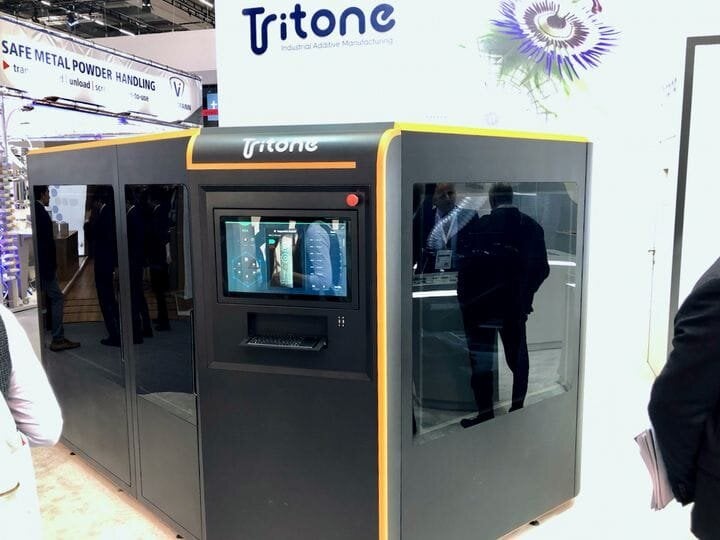![Tritone’s MoldJet 3D printer [Source Fabbaloo]](https://fabbaloo.com/wp-content/uploads/2020/05/image-asset_img_5eb08cb407381.jpg)
Startup company Tritone showed us their unique MoldJet 3D printing process.
The Israeli startup company, founded only in 2017, has produced a fantastic 3D printing process that, after seeing it, seems so obvious. I’m wondering why no one thought of this technique before, but in any case Tritone has it now.
MoldJet Technology
Almost all 3D printing processes focus on printing the actual object, with the sole exception being purpose-built molds for casting. That is usually done for large scale non-3D printable materials such as concrete or even metal.
Tritone has taken the usual 3D printing paradigm and twisted it backwards: instead of 3D printing the desired object, they are 3D printing a mold. Here’s how it works:
-
An arm swings a high resolution inkjet deposition system across a surface
-
Droplets are selectively deposited on the surface in the pattern of a mold
-
The layer is solidified
-
A second pass quickly deposits model material into the void created by the mold – keeping in mind this is one layer at a time
-
The process repeats, layer by layer until the object is finished
-
The print is removed and the mold is washed or melted away, revealing the green prints
-
The green prints are put through a post processing process to remove binder and sinter the particles together to finalize the objects
Tritone explains that the model material deposition process is very much like the recoating process seen in powder bed 3D printers: a blade pushes the material over the layer where it falls into the voids.
Tritone Materials
![A 3D printed metal part made with Tritone’s MoldJet 3D printing process [Source Fabbaloo]](https://fabbaloo.com/wp-content/uploads/2020/05/image-asset_img_5eb08cb452593.jpg)
What types of materials can be used in the Tritone MoldJet process? We’re told they can accommodate “all MIM powders”, meaning metal injection molding powders. These are commonly available at commodity pricing and in countless different materials. This includes both metal and ceramic materials.
Tritone has specifically tested the following materials in the machine:
-
Stainless steels 316L, 15-5 PH, 17-4 PH
-
Tool steels M2, D2, H13, 4340
-
Inconel 718
-
Titanium 6-4
-
Pure Copper
-
Bronze
-
Alumina (ceramic)
Clearly this approach will work with many more material types that have yet to be certified. Of course, you will need a separately supplied sintering furnace to complete the post processing, but Tritone believes many of their target clients will already have such equipment on hand.
The resolution of the parts is quite good, as you can see in this metal 3D print from the Tritone MoldJet machine. I suspect their process can produce parts with resolution proportional to the inkjet deposition.
Tritone Production Features
If the MoldJet process isn’t interesting enough, Tritone has provided additional innovation in how they deploy MoldJet in their 3D printer. While the nominal print volume is a generous 400 x 440 x 120 mm, their machine actually can handle six such plates at once. The idea is to create a kind of “production pipeline”, where the plates can all be at one stage of 3D printing or another.
Another interesting feature is a built-in quality control system. The machine inspects each layer by means of an imaging system. If deviations exceed specified thresholds, the machine can literally scrape off the bad layer and do it again. In this way they can mostly guarantee high quality results for each 3D print job.
These features hint at one of Tritone’s goals: to create a truly production machine, which I believe they have.
We did not obtain specifications, but it is pretty clear that the MoldJet technology can be run at considerable speed. Combining that print speed with the six-plate carousel suggests the machine will have tremendous throughput.
Currently the equipment is in beta testing and the company is seeking additional volunteers to test the MoldJet technology if located in Europe.
Tritone expects to commercialize the system towards the end of 2020, and pricing is not yet set. However, it’s expected the machine will be in the US$450-500,000 range.
Via Tritone

